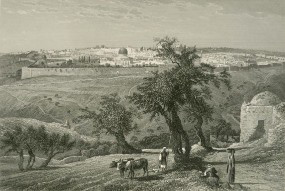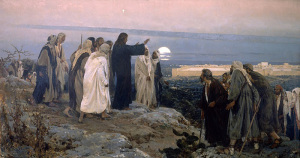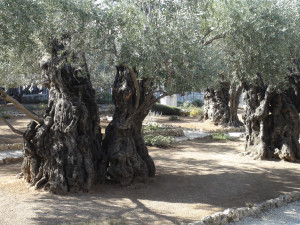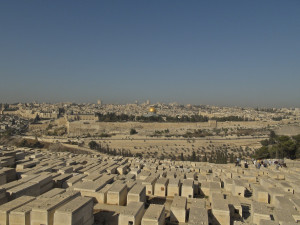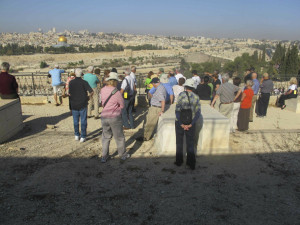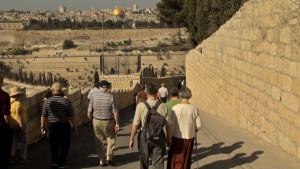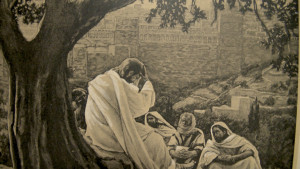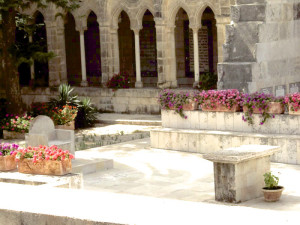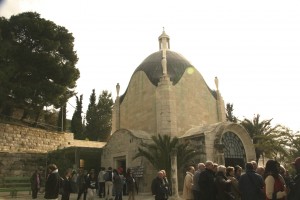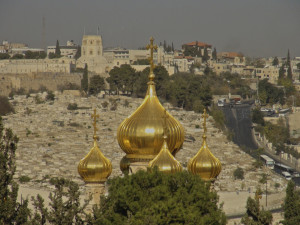The Mount of Olives
Unlike buildings and towns, large mountains last over the centuries, and so the Mount of Olives, the two mile mountain ridge facing the Old City of Jerusalem, is a unique reminder of Jesus Christ who knew it two thousand years ago, according to the gospels. Olive trees that gave the mountain its name still grow on its slopes.
Ancient tombs, some going back to the time of Jesus, tell us this place is holy ground. One day “God’s feet will stand on the Mount of Olives,” calling the dead to be raised, the Prophet Zechariah said.(Zechariah 14,4) The tombs spread along the mountain and into the Kidron valley below are mostly Jewish, though there are Jewish-Christian tombs near the church of the Dominus Flevit, and Mary’s tomb also lies near the garden of Gethsemane. The tombs, facing the ruins of the temple and the holy city, wait for the end time and witness the promise of resurrection.
Jesus as a boy must have come to this mountain after traveling the road from Jericho to Jerusalem to celebrate the Jewish feasts. During the feasts he most likely stayed on the slopes of the mountain or at Bethany, the village on its eastern slopes. It was a favorite place for Galilean pilgrims to Jerusalem. (Luke 21,37-38) He must have stopped on top of the mountain, as many do today, to gaze at the ancient city across the way. Here the gospels say he spoke to his disciples about the days to come. (Mark 13,3-27; Matthew 24,3-25,46)
He wept over the city here: “Jerusalem, Jerusalem, you who kill the prophets and stone those sent to you, how many times I yearned to gather your children together, as a hen gathers her young under her wings, but you were unwilling! Behold, your house will be abandoned, desolate.” (Luke 19,29-44) Roman legions under Titus fulfilled that prophecy in 70 AD, when they destroyed Jerusalem and the temple. Some of the stones thrown down from the temple can still be seen at the base of the old walls.
Towards the end of his life, Jesus rode to the city on a donkey from Bethphage, a town on the road from Jericho, surrounded by followers and admirers who sang and danced and cast palm branches before him. (Mark 11,1,11; Matthew 21,1-11; Luke 19, 28-40; John 12,12-19) The ancient path down the mountain to the city has a good claim to be the one he took.
As he saw death coming, on the night before he died, Jesus prayed here in a garden called Gethsemane at the foot of the mountain. He came with his disciples and fell into an agony. Judas, his disciple, knew the place and led soldiers here; they arrested him and led him away to be tried and humiliated and crucified. (Mark 14, 32 ff; Matthew 26,36 ff; Luke 22,39ff;John 18,1ff)
When Jesus died, Matthew’s gospel says “The earth quaked, rocks were split, tombs were opened, and the bodies of many saints who had fallen asleep were raised. And coming forth from their tombs after his resurrection, they entered the holy city and appeared to many.”(Matthew 24, 51-54) The tombs around the Mount of Olives, all the dead, Matthew indicates, received the promise of Jesus’ resurrection. “He descended into hell.” Like the tomb of Jesus, every grave opens to the promise of risen life.
According to Saint Luke, Jesus taught his disciples for 40 days and then ascended into heaven from the Mount of Olives. (Luke 24,50; Acts 1,1 ff) No wonder, then, that Christians early on were attracted to this holy place with so many associations to Jesus.
By the 5th century, the Emperor Constantine built a large church on the top of this mountain over the spot where tradition said Jesus taught and prayed with his disciples and ascended into heaven. It was called Eleona, after the emperor’s mother, Helena, an early pilgrim devoted to the Holy Land. (See picture below) Luke’s unique view of the ascension, which inspired the building of this church, also inspired our celebrations of the Feast of the Ascension and Pentecost and the easter season.
In the Byzantine era, great numbers of Christians flocked to the three major shrines built by Constantine: the church over the tomb of Jesus in Jerusalem; the church over the cave in Bethlehem and the church on the Mount of Olives where he ascended into heaven. Soon other churches were built to mark events in Jesus’ life. On the Mount of Olives, a church marked the place where Jesus wept over Jerusalem, “Dominus Flevit,” another where he prayed in agony. Over the centuries they were destroyed and rebuilt.
Over time, the Mount of Olives has been a Christian sanctuary where monks and nuns built large monasteries and pilgrims came, as once Jewish pilgrims from Galilee did. As once Jesus did.

